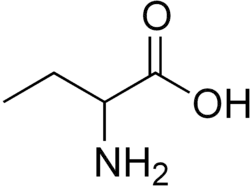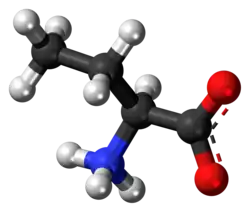α-Aminobutyric acid
 | |
 | |
| Names | |
|---|---|
| IUPAC name
Homoalanine
| |
| Systematic IUPAC name
2-Aminobutanoic acid | |
| Other names
2-Aminobutyric acid; α-Aminobutanoic acid; Ethylglycine;
2-Azaniumylbutanoate | |
| Identifiers | |
3D model (JSmol)
|
|
| ChEBI | |
| ChEMBL | |
| ChemSpider | |
| ECHA InfoCard | 100.018.742 |
PubChem CID
|
|
| UNII | |
CompTox Dashboard (EPA)
|
|
| |
| |
| Properties | |
| C4H9NO2 | |
| Molar mass | 103.12 g/mol |
| Appearance | white solid |
| Melting point | 305 °C (581 °F; 578 K) |
| Acidity (pKa) | 2.55 (carboxyl), 9.60 (amino)[1] |
| −62.1·10−6 cm3/mol | |
Except where otherwise noted, data are given for materials in their standard state (at 25 °C [77 °F], 100 kPa).
Infobox references
| |
α-Aminobutyric acid (AABA), also known as homoalanine in biochemistry, is a non-proteinogenic alpha amino acid with chemical formula C4H9NO2. The straight two carbon side chain is one carbon longer than alanine, hence the prefix homo-. The conjugate base of α-aminobutyric acid is the carboxylate α-aminobutyrate.
Homoalanine is biosynthesized by transaminating oxobutyrate, a metabolite in isoleucine biosynthesis. It is used by nonribosomal peptide synthases. One example of a nonribosomal peptide containing homoalanine is ophthalmic acid, which was first isolated from calf lens.
α-Aminobutyric acid is one of the three isomers of aminobutyric acid. The two other are the neurotransmitter γ-aminobutyric acid (GABA) and β-aminobutyric acid (BABA) which is known for inducing plant disease resistance.
This amino acid has been detected in meteorites.[2]
References
- ^ Dawson, R.M.C., et al., Data for Biochemical Research, Oxford, Clarendon Press, 1959.
- ^ Cronin, John R.; Pizzarello, Sandra (1997). "Enantiomeric Excesses in Meteoritic Amino Acids". Science. 275 (5302): 951–955. Bibcode:1997Sci...275..951C. doi:10.1126/science.275.5302.951. PMID 9020072. S2CID 10979716.